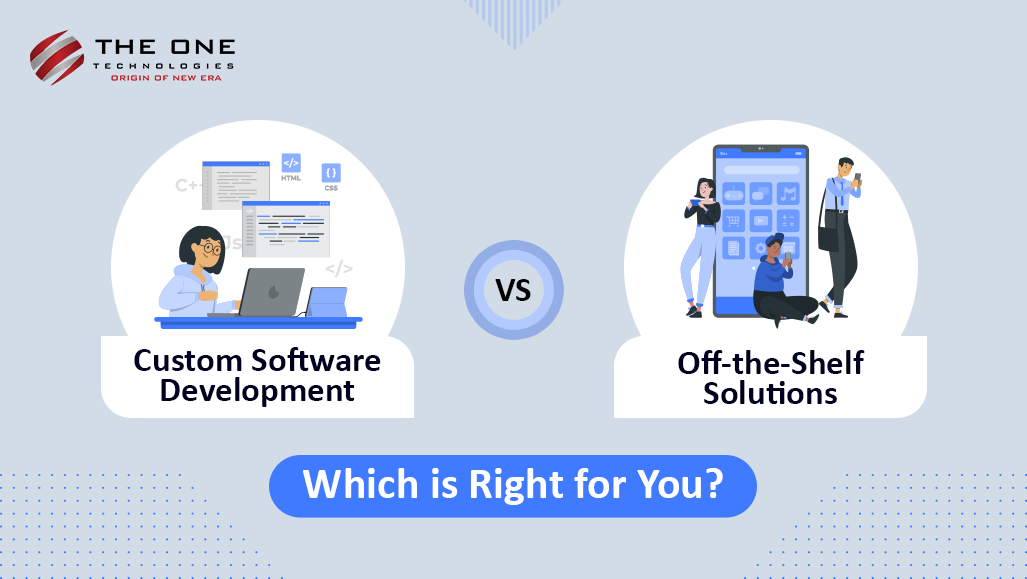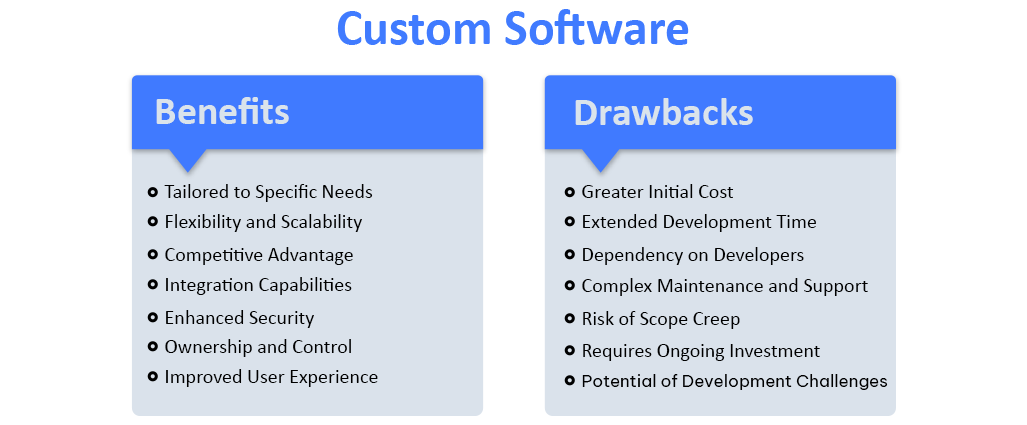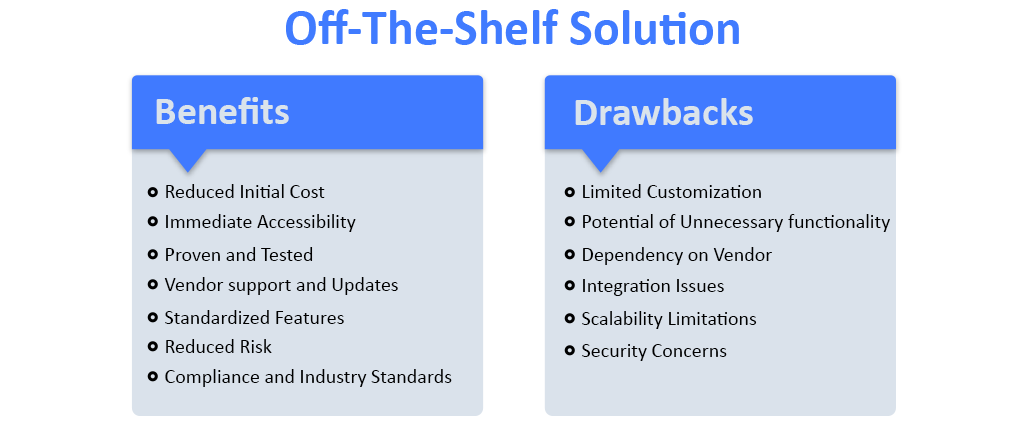Custom vs. Off-the-Shelf Software: What’s Right for You?

Introduction
Businesses are constantly looking for methods to increase productivity, streamline processes, and obtain a competitive edge in the digital arena. Choosing between off-the-shelf solutions and custom software development is a crucial decision that companies must make. This decision has the potential to profoundly affect a company's growth, adaptability, and overall success.
It's important to make a careful choice when choosing between off-the-shelf solutions and custom software. Since every solution has pros and cons of its own, it is crucial for businesses to carefully consider their unique requirements, financial constraints, and long-term goals. We will examine the differences between off-the-shelf solutions and bespoke software development in this blog post, as well as their pros and cons. You will be in a better position to choose the strategy that will work best for your company if you comprehend these important factors, which will ultimately lead to increased productivity and success.
Table of Content
- What is Custom Software Development?
- What is an Off-the-Shelf Solution?
- Factors to Consider When Choosing Between Custom and Off-the-Shelf Solutions
- Conclusion
- People Also Ask
What is Custom Software Development?
The process of designing, developing, implementing, and managing software that is especially suited to satisfy the exact demands and specifications of a given company or organization is known as custom software development. To ensure the best results, you may want to hire dedicated custom software developers who can tailor the solution precisely to your needs.

Benefits of Custom Software Development
Tailored to Specific Needs
Custom software is made to satisfy each company's needs. It offers a solution that specifically solves demands and issues and works in perfect consistency with the organization's workflows, processes, and goals.
Flexibility and Scalability
As a business grows, scalability may be considered while developing custom software, enabling it to adapt and change accordingly. Also, when technology advances and business requirements change, the software may be changed and updated.
Competitive Advantage
Custom software can give an advantage over competitors by offering features and functionalities that are particularly designed for the business. It makes it possible to apply special solutions that aren't found in off-the-shelf goods, which could increase market distinction and efficiency.
Integration Capabilities
Custom software can be made to work flawlessly with the organization's current tools and systems. This guarantees a unified technology and makes data interchange and process automation easier.
Enhanced Security
Security can be a primary concern when developing custom software, and steps to mitigate certain risks and vulnerabilities can be included. In comparison to generic solutions, which might not handle every security issue, this can lead to a software environment that is more secure.
Ownership and Control
Companies who use custom software are in total control of the application. They have the power to drive upcoming features, updates, and modifications, making sure the program keeps up with their changing requirements.
Improved User Experience
Custom software can provide a more streamlined and intuitive user experience because it is created with the needs of the specific users in mind. Increased customer satisfaction and adoption rates may result from this.
Drawbacks of Custom Software Development
Greater Initial Cost
Compared to off-the-shelf options, custom software development frequently entails a larger initial expenditure. The price is indicative of the custom nature of the design, coding, and testing phases of the development process.
Extended Development Time
Custom software development entails a thorough process of requirement analysis, design, development, and testing, so it might take a long time. The time to market and implementation may be delayed by this extended schedule.
Dependency on Developers
Companies may grow dependent on the development team to provide continuous maintenance, upgrades, and support. If the developer or development business is no longer available, or if there are problems in the partnership, this dependency may become troublesome.
Complex Maintenance and Support
Compared to off-the-shelf solutions, maintaining and supporting custom software might be more difficult. It's possible that the program will need regular upgrades and fixes, which can be resource-intensive and need certain expertise.
Risk of Scope Creep
When features and requirements change from the original design, it's known as scope creep and can affect custom software projects. This may result in higher expenses, longer development times, and even delivery delays.
Requires Ongoing Investment
Custom software frequently needs continuous funding for upkeep, upgrades, and future improvements in addition to the initial cost of development. One must budget for this long-term financial commitment.
Potential of Development Challenges
There are several potential obstacles that custom software development projects may encounter, such as unexpected problems, technical difficulties, and project management issues. These difficulties may affect the project's overall performance and completion.
What is Off-the-Shelf Solution?
Pre-built software solutions easily accessible for purchase and utilization by people and enterprises are called "off-the-shelf" solutions. These solutions have standardized features and functionalities that may solve common demands across different industries, and they are made to cater to a wide range of consumers.

Benefits of Off-the-Shelf Solutions
Reduced Initial Cost
Compared to custom software development, off-the-shelf solutions can have a cheaper upfront cost. As the cost is shared by many users, the price is often lowered, making it an affordable choice for many enterprises.
Immediate Accessibility
These solutions are easily bought and used, enabling companies to install and begin utilizing the software almost right away. This speedy deployment can be very important for companies that require immediate fixes.
Proven and Tested
Several people have utilized and tested off-the-shelf software items. Due to its widespread use, the program is often dependable and stable, with most problems and flaws found and fixed.
Vendor support and Updates
Pre-made solutions typically include customer assistance, training materials, and frequent updates from the vendor. This might be very helpful for companies without technical staff members.
Standardized Features
A collection of features that are intended to satisfy the shared requirements of a broad spectrum of consumers are included with these solutions. Businesses who don't need much customization but need basic functionalities may find this useful.
Reduced Risk
Businesses can test out off-the-shelf software through trials or demos before making a purchase. Because users may determine a software solution's suitability in advance, this lowers the risk involved in software investment.
Compliance and Industry Standards
A lot of commercial products are designed to adhere to industry norms and regulations. This can be helpful for companies that have regulatory requirements that they must follow.
Drawbacks of Off-the-Shelf Solutions
Limited Customization
Off-the-shelf software is meant to be used by a wide range of users, so it might not provide the degree of modification required to meet particular or unusual business needs. This may result in a mismatch between the requirements of the organization and the program.
Potential of Unnecessary functionality
These solutions might have functionality that not all users would need, which could make the interface cluttered and possibly decrease user productivity. It's possible for businesses to pay for features they never use.
Dependency on Vendor
Companies that use commercial software rely on the vendor for future development, upgrades, and support. Users may face difficulties if the vendor discontinues the product or does not offer sufficient support.
Integration Issues
It might be difficult to integrate off-the-shelf software with current tools and systems. There could be potential inefficiencies and data silos if the software does not interact effectively with other programs or procedures that are currently in use.
Scalability Limitations
When a business expands, off-the-shelf solutions could not scale well. They might not be able to handle growing data volumes or user counts, which could cause problems with performance or necessitate the usage of extra solutions.
Security Concerns
Since generic solutions might not cover every unique security requirement of a company, there may be holes that could be exploited. Companies are forced to rely on the security measures offered by the vendor, which might not always meet their unique needs.
Factors to Consider When Choosing Between Custom and Off-the-Shelf Solutions
1. Business Needs and Objectives
- Custom Solutions: Ideal if you have specific requirements that are not adequately met by off-the-shelf products. Custom software can be tailored to align precisely with your business processes and goals.
- Off-the-Shelf Solutions: Suitable for businesses with standard needs that are well addressed by existing software. These solutions provide generic features that may meet basic or common requirements effectively.
2. Budget Constraints
- Custom Solutions: Generally, require a higher initial investment due to development, design, and testing costs. Consider if the long-term benefits and tailored features justify the higher upfront cost.
- Off-the-Shelf Solutions: Usually have a lower initial cost and may offer a more predictable pricing structure. This is beneficial for businesses with budget constraints looking for an affordable, immediate solution.
3. Timeframe for Implementation
- Custom Solutions: Typically involve a longer development time, from requirements gathering to deployment. Assess if you have the time to invest in a custom solution or if quicker implementation is needed.
- Off-the-Shelf Solutions: Available for immediate use, allowing for faster deployment. This can be advantageous if you need a solution quickly to address urgent business needs.
4. Long-Term Business Strategy
- Custom Solutions: Can be designed with scalability and future growth in mind. Consider if you need a solution that can evolve with your business and adapt to long-term strategic changes.
- Off-the-Shelf Solutions: May have limitations in scalability and adaptability. Evaluate if the solution will continue to meet your needs as your business grows and changes.
5. Industry-Specific Requirements
- Custom Solutions: Ideal if your business operates in a niche industry with unique requirements that are not addressed by standard software. Such software can incorporate industry-specific features and compliance needs.
- Off-the-Shelf Solutions: Often designed to serve a broad range of industries. If your industry needs are well covered by existing solutions, off-the-shelf software may be sufficient.
6. Integration with Existing Systems
- Custom Solutions: Can be developed to integrate seamlessly with your existing systems and tools, ensuring smooth data exchange and process continuity.
- Off-the-Shelf Solutions: May face challenges with integration, especially if the software does not easily connect with your current systems or requires additional customization for compatibility.
7. User Experience and Usability
- Custom Solutions: Designed with your specific users in mind, offering a tailored user experience and interface that aligns with your team’s workflow and preferences.
- Off-the-Shelf Solutions: May have a more generic user interface that may not perfectly fit your organization’s specific needs, potentially impacting user adoption and efficiency.
Conclusion
Choosing between custom software development and off-the-shelf solutions requires a thorough assessment of your organization’s specific needs, budget, and future goals. Custom software offers a tailored approach, flexibility, and a unique competitive advantage, making it a strong choice for businesses with distinct requirements and the capacity to invest in a bespoke solution. On the other hand, off-the-shelf software provides immediate implementation, lower upfront costs, and proven reliability, making it suitable for businesses looking for a cost-effective and standardized option. Whether you opt for a personalized solution from a dedicated custom software development company or choose an off-the-shelf product, the key is to align your choice with your strategic objectives and operational needs to ensure the best fit for your business.
People Also Ask
What is the main difference between custom software development and off-the-shelf solutions?
Custom software development involves creating a tailored software solution designed specifically to meet the unique needs and requirements of a business. In contrast, off-the-shelf solutions are pre-built software products available for immediate purchase and use, designed to address the general needs of a broad audience.
What are the benefits of choosing custom software over off-the-shelf solutions?
Custom software provides tailored features that fit your unique business processes, offers scalability to accommodate future growth, and ensures better integration with existing systems. It also provides a competitive edge with unique functionalities and enhanced security designed specifically for your organization.
How do costs compare between custom software development and off-the-shelf solutions?
Custom software development typically involves a higher initial investment due to the bespoke nature of the solution and the development process. Off-the-shelf solutions generally have lower upfront costs, as the expense is shared among many users, making them a more affordable option in the short term.
How long does it take to implement custom software compared to off-the-shelf solutions?
Custom software development usually takes longer to implement, as it involves a detailed design, development, and testing process. Off-the-shelf solutions can be deployed almost immediately after purchase, allowing for quicker implementation and use.
Can off-the-shelf solutions be customized to fit specific business needs?
While off-the-shelf solutions offer limited customization options, some may allow for minor adjustments to fit specific needs. However, they are generally designed with standardized features, and significant customization may not be possible or cost-effective.
How do you handle changes in project requirements during the development process?
We manage changes through a structured change management process. Any modifications to the project scope or requirements are discussed and documented, and we provide updated timelines and cost estimates as needed. Our goal is to accommodate changes while maintaining project goals and deadlines.










